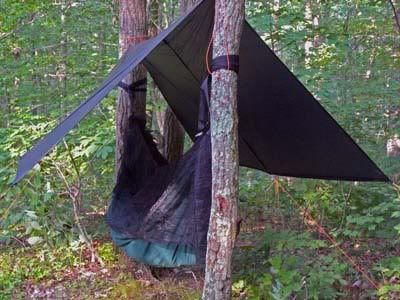- No extra padding is needed underneath for comfort. (Insulation is still needed underneath for warmth.)
- No wet ground to worry about in the rain.
- I can make camp anywhere there are two trees spaced adequately, including over uneven, steep, or rocky ground.
- Crawling insects and other critters are much less of a problem.
- In hot weather, ventilation is excellent due to sleeping on nothing but thin, air-cooled fabric.
- Using a small alcohol stove, I can cook under the tarp on rainy days. I can even do this while laying in the hammock.


Tarp
- weight: around 18 oz with guylines and titanium stakes
- fabric: 1.1 oz silnylon fabric
- size: 8' x 10'
- Guylines are 1/16" spectra core with orange nylon sheath (Ed Speer's No Tangle Guylines)
- 6 titanium stakes
- Grommets at ridge tabs only for use with sticks or hiking poles when sleeping on the ground
Hammock
- weight: around 2 lbs with webbing
- fabric: Supplex nylon (more durability and weight support compared to 1.9 oz ripstop nylon)
- size: Single piece of fabric, around 10' 7" long
- Bug net (black noseeum mesh) will eventually attach to hammock with zippers, but here it's just draped over the hammock
- Ends are gathered in a specific pattern (similar to a Hennessey Hammock) and whipped with a bootlace
- 1" heavy weight polypropylene webbing, 13' on each end, tied to tree with a four wrap knot
Recent Modifications
- Added tie-out to side of hammock to prevent the side from hanging in my face.
- Changed the hammock suspension from simple webbing tied to trees to using steel cinch buckles for easier adjustment. This also allows the long pieces of webbing which wrap around the tree to be stored separately from the hammock to keep sap and pieces of bark from the webbing out of the hammock.
- Added climbing-rated carabiners to the end of the webbing to do a simple single wrap around the tree. The cinch buckles and carabiners add some weight, but allow faster setup and precise adjustment of the hammock position and hang.
- Made "snakeskins" from mesh to store the tarp and allow it to be hung over the hammock without blocking views of the sky, but ready for staking out at the first sign of rain
- The 1/16" tarp cord on the ends is too thin for tying to trees because it cuts into the bark too easily. A deep enough cut encircling the tree will kill it. I'm going to switch to 550 paracord.
- I'm going to experiment with using a ridgeline instead of the current end tie-outs on the tarp. I'll put prussik loops on each end, and then clip the tarp ends onto those to allow for precise positioning over the hammock and tension adjustment.
- I have added 18" lengths of paracord to the ends with loops tied every 5" for easily storing gear I want to keep accessible inside the hammock.
love the article. refreshing to find value. you would be welcome to post on my blog.
ReplyDeletethanks. rob
Last weekendwas my first time camping in a hammock. Waaaaaaay better than sleeping on the ground!!
ReplyDeleteGreat article!!
Did you make or purchase your hammock? Great blob by the way! I hope to see more soon!
ReplyDeleteThank you everyone.
ReplyDeleteNorseman, I made my hammock from Supplex nylon for durability and weight-bearing. I would go with 1.9 oz ripstop if I were to make another though. The Supplex is a bit heavier, and it tends to be harder to slide around to get into just the right sleeping position.
I have actually went back to ground sleeping for most of this summer. I'm a stomach sleeper, and despite its comforts, sleeping in a hammock is a compromise on my preferred sleeping position. I will continue to experiment and maybe try a bridge hammock, which allows for flat stomach sleeping. In the hot, humid summer nights, a hammock is almost required to get any sleep.
Nice rig :o) Check out my system.The hammock itself weighs a just 17 oz. with the cinch buckles and webbing, or I can add the bug net adding 8 oz. making it 25 oz. Because I live so far north I add a speer peapod for summer and in winter I have a -15c Mountain hard wear mummy bag to go inside the pod. Along with my Warbonnet superfly with doors. The whole thing is good for -25c to -30c and only weighs 91/2 lbs. total. Which is pretty good for those temps :o)
ReplyDeletehttp://www.youtube.com/watch?v=eKODYx7EtR0